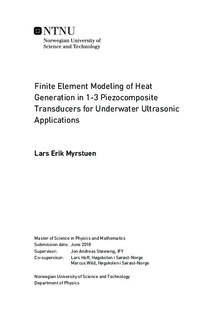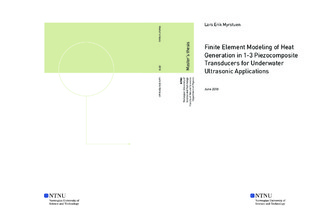| dc.description.abstract | Today, piezoelectric ultrasound transducers are used extensively for underwater applications such as sonar. In such transducers, operating in thickness mode, the active part is often a 1-3 piezocomposite, usually made of lead-zirconate-titanate rods embedded in a passive polymer/epoxy matrix. One or several matching layers can be connected to the piezocomposite for increased acoustic transmission into water. Upon electrical and/or mechanical excitation, the transducer will heat up due to mechanical, dielectric and piezoelectric losses.
In this thesis, the heat generation in 1-3 piezocomposite transducers was investigated following three steps. First, the heat generation in 1-3 piezocomposites due to material energy loss mechanisms was investigated through the use of the finite element method for varying lead-zirconate-titanate volume fractions and square lateral rod sizes. For both composite materials, the losses were represented through complex material coefficients. The composites were electrically excited by a sinusoidal voltage. The simulations were built in the COMSOL Multiphysics software and run over frequency intervals extending over the fundamental thickness resonance and anti-resonance frequency of the composites.
Second, one of the composites was connected to a quarter-wavelength matching layer with losses incorporated through complex material coefficients. A water load was applied to the front face of the matching layer.
Finally, the resultant spatial heat generation was used as the heat source in a steady-state heat transfer model of the same structure. A constant temperature boundary condition was applied to the interface between the matching layer and water load, and convective heat transfer between an air backing layer and the composite was assumed. It was found that the resultant spatial temperature distribution was homogeneous in planes normal to the thickness direction to a very high degree, both in the composite and in the matching layer. Using a peak voltage of 200 volts, a maximum temperature rise of approximately 24 kelvin was obtained. | en |

